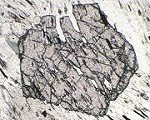Practical Aspects of Mineral Thermobarometry
Simplified models, and Darken's Quadratic Formalism
A simplified approach to dealing with formulations for activity coefficients in complex phases with regular and reciprocal interactions is presented by Powell and Holland (1993) Am. Min. 78, 1174-1180.
[ more to come here ... ]
Darken's quadratic formalism
We expect the activity coefficient for a species i to behave differently at the dilute end (Henry's Law) and at the high concentration end (Raoult's Law) of the range. In many cases it can help to circumvent the problem of fitting a single model for activity-composition relations across the entire range if we adopt an approach called Darken's quadratic formalism [Powell (1987) American Mineralogist 72, 1-11]. With this approach we consider each end of the solid solution series as a separate region, and treat each region as a regular solution between one real end member and one fictive end member. The "quadratic" part of the name comes from the simplest formulation for a binary solution in which ln(activity coefficient) is proportional to (1-Xi)2.
An application of Darken's Quadratic Formalism to plagioclase can be found in Holland and Powell (1992) American Mineralogist 77, 53-61.
Sources and further reading
The full references for the citations given above are:
- Holland, TJB, and Powell, R, (1992). Plagioclase feldspars: activity-composition relations based upon Darkenís Quadratic Formalism and Landau theory. American Mineralogist, 77, 53-61.
- Powell, R, (1987). Darken ís quadratic formalism and the thermodynamics of minerals. American Mineralogist, 72, 1-11.
- Powell, R, and Holland, TJB, (1993).On the formulation of simple mixing models for complex phases. American Mineralogist 78,1174 Ė1180.
This page last modified 12 October 2004
